Well in the well - a very good solution to the problem, but
How often we are greatly deceived in our expectations before starting a big business. It would seem that it is simpler to drill a well in an already completed well, when a significant part of the work on dredging into the formations may already have been done.
But it was not there. Sometimes the amount of work that needs to be done to continue drilling is so great that it is fitting to call this situation in an everyday way “zamanuha”. Nevertheless, it is worthwhile to try to consider this possibility and, if lucky, then, indeed, the problem of obtaining water in this way can be solved with less cost.
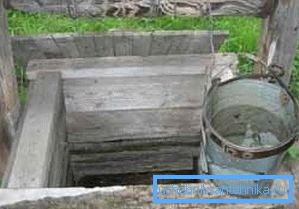
Not always ready well will help with a well - 50 to 50

In the presence of the well, there are two significant advantages:
- First, you get a guaranteed point of drilling, where you can say with high probability that there is water.
- Secondly, at your disposal there is a ready deepening and you have to drill not from a zero point, but already from a depth of 5-8 meters.
Background and types of wells
The prerequisites for drilling in the existing well are quite objective:
- both structures have a very similar construction, they differ only in the diameter of the casing and the degree of penetration into the aquifer - the wells are often also called “tubular wells”;
- besides, it is not by chance that there is an Abyssinian well, also called Norton - in essence, these are wells with a 20-50 mm pipe lowered into it and a tip entirely in small through holes; using the drill pipe penetrates into the aquifer, and the rise of water up is made by the pump;
It does not interfere with recalling three more types of wells:
- shaduf - a leverage system in the form of a crane is used to lift water;
- Russian - a log, lockable top mine, supplied with a collar with a chain and a bucket - a ubiquitous detail of the landscape of the Russian village;
- with the use of an Archimedean screw - the supply up is ensured by the continuous rotation of the screw, between the blades of which the next portion of water flows.
All three types are basically mine, which can be used if it ceased to perform its functions in the proper amount.
In addition, according to the position of its lowest point relative to the water layer, wells can also be divided into three types:
- A - imperfect (incomplete) - if such a well does not contain water, then there is a high probability to get water by drilling from the same stratum, which is achieved with minimal effort;
- B - perfect (full) - through such a well will have to break through to the next aquifer;
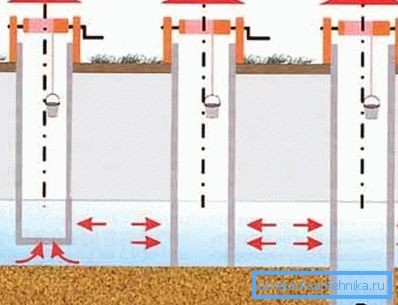
- C - perfect with sump (D) - also need to analyze the availability of water even lower.
What is at our disposal and the place of wells in the overall system
Imagine also the place of the funds in question in the total water extraction system at the site:
First, all the work takes place in an environment of sufficient support:
- A - artesian aquifer;
- B - pronounced movement of water;
- C - the indispensable availability of groundwater;
- D - permanent precipitation, as the main source of water supply of soil.
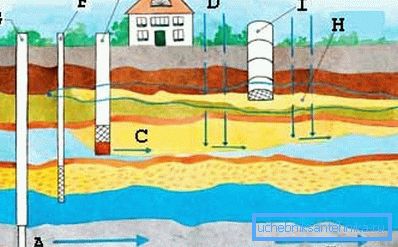
If the whole environment is "in perfect order", then at your disposal:
- E - the ability to create a well-well;
- F - water intake from sand;
- G - limestone well;
- H - top water - production of water from the uppermost layers of the soil, not deeper than 10 meters;
- I - well.
Progress and cautions
The course of work consists of several stages.
Feasibility study
Here it is necessary to carry out the following actions:
- First, the study of the presence of lower water layers. This is best done by the results of the work of the sources of the neighbors.
Helpful advice! When analyzing the work of the water sources surrounding you, we advise you to create a peculiar scheme of layers and wells, consisting of two plans - placement on the ground (horizontal plan) and depths of water intake from each source (vertical plan). As points of the horizontal plan, choose points located on all sides of the prospective point of your well drilling and at different distances. The only goal is to collect as much information as possible about the situation with aquifers in your area.
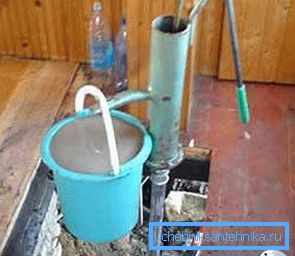
- Secondly, to analyze the state of the design of the well itself.. The most important thing here is that the structure should not be loose. It is necessary to take into account that its forming rings will experience strong oscillatory effects from the drilling mechanism. From here two conclusions:
- if the structure has signs of deformation, then it must be strengthened;
- even if the structure is in visible order, it will be necessary to strive in every way to compensate for the effect on it when drilling a well, as was done in photo “A” - horizontal bars are welded, which simultaneously guide the drill down.
Technology
When all the conditions are met, the technology of drilling from the bottom of the well will not undergo large differences compared to drilling from the surface, and the solution to the question of how to make a well in the well will be as follows:
- drilling is performed by conventional drilling rigs — a rotary method with flushing is often used;
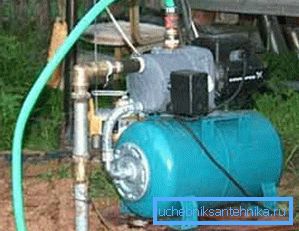
- a metal pipe with a diameter of 20-30 cm, corresponding to the diameter of the drill, is immersed into the well, through the guides (a good example is the photo “A”);
- the pipe is driven into the bottom, which may require heavy equipment, up to a crane;
- further the drilling process inside the pipe takes place; We note that slags are also thrown to the bottom, as a result, it will be unsuitable for further use;
- for drilling, you can choose a hand drill and, thus, do all the work yourself; but this method is applicable on light soils with a shallow bed of water and a shallow well - in all other cases we advise that this project with independent drilling through the well be set aside as little and very difficult to implement.
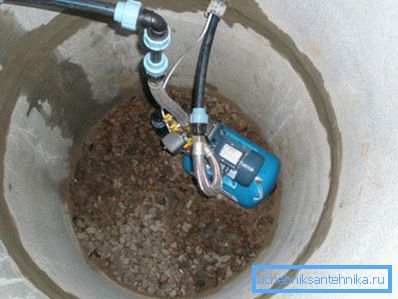
findings
The question whether it is possible to drill a well in a well, rather has the answer, no, than yes. At least, the price of all works may be prohibitively high and no instruction guarantees the availability of water, even though it was once there.
However, in one of the three cases it is worth trying, there is a chance that the earth will treat you more favorably. Before you decide, watch the video in this article, it will definitely remind you about the main nuances of future work and will be able to adjust to the desired mode.